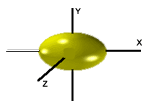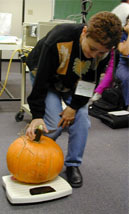Pumpkins


Activity:
Before you carve a pumpkin, estimate its volume, and weigh it. Make a graph plotting the pumpkins' weights against their volumes.
![]() Supplies: Pumpkins, scales, rulers, boxes/cardboard/notebooks to establish sides of pumpkin.
Supplies: Pumpkins, scales, rulers, boxes/cardboard/notebooks to establish sides of pumpkin.
Part 1. Measuring Volume
The volume of a sphere with radius r is 4/3*pi*r3.
There are shapes close to a sphere called ellipsoids. If you stretch a sphere in one direction, and then in a direction perpendicular to the first one, and finally in a direction perpendicular to the first two, you get an ellipsoid.

An ellipsoid does not have just one diameter. Call the longest diameter x and the shortest diameter y, and call the width in the third direction z. Then the ellipsoid's radii are x/2, y/2, and z/2.
Stretching or compressing a sphere (or any solid) in one direction by a factor f multiplies its volume by f, and so V changes to f*V. Stretching or compressing a solid in three directions by factors f1, f2, and f3 multiplies its volume by f1*f2*f3, so V changes to f1*f2*f3*V.
If you stretch a sphere with radius r in three directions by factors (x/2)/r, (y/2)/r, and (z/2)/r, you will get an ellipsoid with radii x/2, y/2, and z/2.
The volume of the ellipsoid is
| V | = |
4/3*pi*r3((x/2)/r)*((y/2)/r)*((z/2)/r)
|
|
=
|
4/3*pi*x*y*z/23
|
|
| = |
(pi/6)*x*y*z
|
Since pi is approximately 3, this means the volume V of the ellipsoid is approximately equal to x*y*z/2.
This gives a simple formula for estimating the volumes of shapes that look like ellipsoids. Measure the longest and shortest diameters. If they are approximately perpendicular, measure the third diameter. Half of their product is the volume. This also means that an ellipsoid approximately fills half of a box in which you would pack it.

Treat a pumpkin as an ellipsoid. Using two rulers, measure its height; this will be one diameter.

By placing two notebooks or pieces of cardboard on two sides of the pumpkin (be sure the notebooks are parallel), you can measure between them to get a second diameter.Now move the notebooks ninety degrees ( and keep them parallel), and measure the length of a third diameter.
Example:
Height h = 9 in.
One diameter is 7 inches, and a third is 8.25 inches.
Volume = 9*7*8.25/2 = 259.875 cu. in., which rounds to 260 cu. in.
It seems to be a lot, but let's convert it into cubic feet.
1 cu. ft. = 123 cu. in. = 1728 cu. in.
Therefore,
V = 260/1728 cu. ft. = 0.15 cubic feet.
It is less than 1/6 of a cubic foot. Not very much! (As a comparison, one US gallon is 231 cubic inches, or about 0.13 cubic feet, about 1/8 of a cubic foot, fairly close to the volume of our example pumpkin!)
There are other ways to estimate the volume of a pumpkin. Can you think of some?
Part 2: Weighing the pumpkin.


We are using a digital scale that weigh up to 10 lb. Our pumpkin weighs 7 lb 13.4 oz. This is 7.8375 lb.
Part 3. Graphing the data.
Compile the data from the class, and make a graph, with weight on the x-axis and volume on the y axis (or vice versa).
What do you see?
If their average densities were the same then the points would lie along a straight line.
But pumpkins have empty centers, so there are three possibilities.
(Or a combination of all three factors)